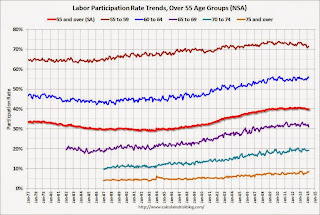by Calculated Risk on 4/06/2014 12:12:00 PM
Sunday, April 06, 2014
Labor Force Participation Rate Update
A key point: A significant decline in the participation rate had been expected, and probably half or more of the recent decline in the participation rate was due to changing demographics (and long term trends), as opposed to economic weakness.
A few key long terms trends include:
• A decline in participation for those in the 16 to 24 age groups. This is mostly due to higher enrollment rate in school (see the graph at Get the Lead Out Update). This is great news for the future and is possibly related to removing lead from the environment (see from Brad Plumer at the WaPo: Study: Getting rid of lead does wonders for school performance)
• There is a general long term trend of declining participation for those in the key working years (25 to 54). See the second graph below.
• There has been an increase in participation among older age groups. This is probably a combination of financial need (not good news) and many workers staying healthy or engaged in less strenuous jobs.
Of course, even though the participation rate is increasing for older age groups, there are more people moving into those groups so the overall participation rate falls.
As an example, the participation rate for those in the "55 to 59" group has increased from 68.4% twenty years ago, to 71.6% now. And the participation rate for those in the "60 to 64" age group has increased from 44.7% to 55.9% over the same period. However, even though the participation rate for each age group has been increasing, when people move from the "55 to 59" age group to the "60 to 64" group, their participation rate falls (from 71.6% to 55.9%). And right now a large cohort is moving into these older age groups, and that is pushing down the overall participation rate.
Here is an update to a few graphs I've posted before.
 Click on graph for larger image.
Click on graph for larger image.
Here is a repeat of the graph I posted Friday showing the participation rate and employment-to-population ratio.
The Labor Force Participation Rate increased to 63.2% in March (blue line). This is down slightly from 63.3% in March 2013.
This is the percentage of the working age population (16 and over, Civilian noninstitutional population1) in the labor force.
Here is a look at some of the long term trends (updating graphs through March 2014):
 This graph shows the changes in the participation rates for men and women since 1960 (in the 25 to 54 age group - the prime working years).
This graph shows the changes in the participation rates for men and women since 1960 (in the 25 to 54 age group - the prime working years).
The participation rate for women increased significantly from the mid 30s to the mid 70s and then flattened out. The participation rate for women in March was 74.2%.
Note that the trend for prime working age women was down BEFORE the recession. This might be because of changing values, economic situations, or demographics (as an example, the cultural norms for some recent immigrant groups is for the women to work at home).
The participation rate for men decreased from the high 90s decades ago, to 88.5% in March. This is just above the lowest level recorded for prime working age men. This declining participation is a long term trend, and the result of inherited wealth - OK, just joking - the reasons for this decline in working age men participation are varied and need more research, however some analysts incorrectly blame this trend solely on more social benefits.
 This graph shows that participation rates for several key age groups.
This graph shows that participation rates for several key age groups.
There are a few key long term trends:
• The participation rate for the '16 to 19' age group has been falling for some time (red). This is directly related to more education.
• The participation rate for the 'over 55' age group was been rising since the mid '90s (purple), and has started to decline recently. Now that the leading edge of the baby boomers are over 65, the 'over 55' participation will decline.
• The participation rate for the '20 to 24' age group fell recently too (more education before joining the labor force). This appears to have stabilized.
 The last graph shows the participation rate for several over 55 age groups. The red line is the '55 and over' total seasonally adjusted. All of the other age groups are Not Seasonally Adjusted (NSA).
The last graph shows the participation rate for several over 55 age groups. The red line is the '55 and over' total seasonally adjusted. All of the other age groups are Not Seasonally Adjusted (NSA).
The participation rate is generally trending up for all older age groups.
The '55 and over' participation rate is starting to decline as the oldest baby boomers move into even older age groups.
1 From the BLS: "Civilian noninstitutional population (Current Population Survey) Included are persons 16 years of age and older residing in the 50 States and the District of Columbia who are not inmates of institutions (for example, penal and mental facilities, homes for the aged), and who are not on active duty in the Armed Forces."


